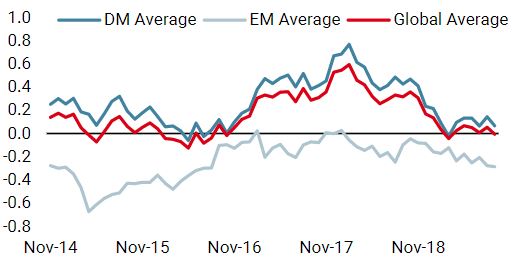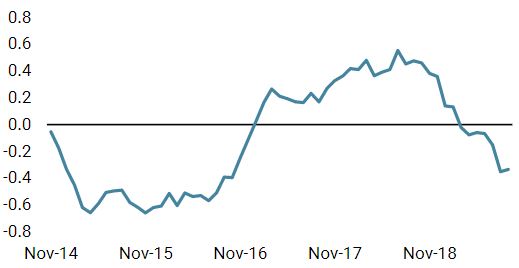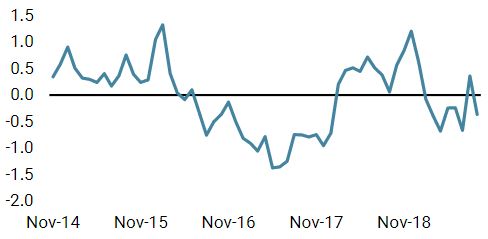Markets have been hooked on central banks and their very accommodative monetary policies for almost a decade now. What had been a vital antidote to one of the worst financial crises in history has become a hard drug on which most investors have got high and highly dependent. We are seven years on from Mario Draghi’s “whatever it takes” speech and the latest ECB meeting proved that he was ready to do so, even if it was with very little consensus. Currently, the trillion dollar question is whether central bank action is necessary and whether additional stimulus will be successful in tackling recessionary and, more importantly, deflationary forces. At this late stage in the economic cycle, ammunition seems scarce and the market reaction following the ECB announcement could indicate that “the world is not enough”. The reason behind central banks’ headache is not risk of recession (yet?) but undershooting inflation, which in turn could lead to damaging deflation. In most speeches, policy makers reckon that economic growth has been downward sloping from early 2018’s above-potential peak and that the balance of risks are tilted to the downside. Yet, they remain confident that recession is not near (in spite of yield curve pricing), particularly the Fed. Conversely, the lack of inflation is the focal point. Is it normal to have so little price pressure when growth has been strong for such a prolonged period and the influx of money mostly unlimited? There are secular forces at work weighing on inflation globally, like demographics (the effects of aging on consumption habits), automation (putting pressure on wages) and digitalisation. There are also cyclical elements missing this time around: the commodity cycle and investment. Usually, after sustained periods of growth, commodity prices reach their peak on the back of supply and demand imbalances, and negatively affect both consumers and companies suffering from higher input costs. Our proprietary Inflation Nowcaster not only indicates a deterioration in inflation conditions, it also indicates that not a single inflation component is showing signs of strength: from wages to input prices, imported and expected inflation, all are low and going lower. And it is happening all across the developed and emerging world. As a result, it provides central banks with breathing space and allows them to ease and pump as much money as possible into the system, helping the world to prolong growth and revive inflation. Expectations have climaxed and it looks like there can only be disappointment ahead. Looking at interest rates pricing, a total of 250bps cuts are currently priced in the G10 12 months ahead, with at least one to two cuts expected in every country, apart from the Nordics. In the US, investors are still factoring in three cuts 12 months ahead (from four recently). The market reaction on the ECB meeting highlights the shape and form of disappointment. Sentiment reversal hit bonds hard, sending bund yields up 10bps intraday to close the day higher, on the very day Draghi announced a rate cut and revived asset purchases. Positioning in hedging assets, especially bonds, reached extreme levels, and the fact that the decision was reached with a low consensus outweighed any satisfaction from the promise of fresh accommodation. There are now two possible outcomes that could arise from the mismatch in perception between the patients and the doctors. Sentiment could lift as macro conditions remain around potential and easing remains in place (our scenario); or a lack of confidence in the ability of policy makers to avoid the end of the cycle could prompt a correction in the price of financial assets. Regarding asset prices, valuations are rich across the investment spectrum, with hedging assets leading. Government bond yields have plummeted to historical lows, the Japanese yen has appreciated back to February 2018 high stress levels and implied volatility remains expensive, in spite of rising risk appetite. The question now is whether to think in “normative” or “pragmatic” terms when assessing if this year’s market rally is near the end and if we are getting closer to a valuation reversal. It usually needs a catalyst to trigger valuation squeezes and large-scale sector/asset rotation, and central bank surprises can be a game changer in that respect. It might be too early to call for a sell-off in overcrowded/rich positions. Indeed, the truth is that central banks have created buckets of expensiveness that some would even call asset bubbles. It is crucial to be mindful of this factor now that incremental action from policy makers (on top of what is already in prices) remains to be seen. Investors will start paying attention to the level of asymmetry and dry powder left in every asset class, and the most expensive ones could suffer heavy losses to benefit once overlooked, cheaper, out-of-favour opportunities. For now, monetary support is alive and well, and expensive risk premia could remain so while it lasts.“The World Is Not Enough” – Garbage, 1999
What’s Next?
Macro: The First Negative Inflation Surprise Ever
Sentiment: When You Reach for the Moon, the World is Not Enough
Valuation: Expensive for Longer

Asset Allocation: Risk ON, but Vigilant
The biggest fear for asset allocators is correlation distortions, if not shocks. Diversified portfolios rely on historical interaction between assets, which have been largely manipulated by quantitative easing. So far, it has been a supportive driver to most assets but mean reversion in correlations are to be anticipated, even temporarily. At the moment, hedging assets seem the most vulnerable to the combination of resilience in economic growth, extreme positioning and tense valuations. For that reason, we have reduced substantially our exposure to the asset class and have reallocated to growth-related assets, credit first. For the same reasons, corporate spreads will be supported by the quest for yield and carry, the lack of recession and positive developments in sentiment and appetite for risk. More generally, the current environment is benign for risky assets, and we have increased exposure to equities and volatility (on the short side). Our attention is geared toward assessing if the disappointment on the ECB front will follow from other central banks, which could indicate that the world will no longer be enough to keep investor optimism afloat, prompting us to trim market exposure globally.

The World Is Not Enough

Our medium-term view is currently more constructive, as we are still overweight growth assets and underweight real assets. We are also complementing our exposures with options to protect the portfolio in the case of equity drawdowns. In September so far, the Multi Asset Risk Targeted Strategy has gained 0.8% versus 3.4% for the MSCI AC World Index and -1.6% for the Barclays Global Aggregate (USD hedged). Year-to-date, the Multi Asset Risk Targeted Strategy has returned 10.0% versus 17.6% for the MSCI AC World index, while the Barclays Global Aggregate (USD hedged) index is up 7.6%. * The Multi Asset Risk Targeted Strategy performance is shown in USD net of fees for the representative account of the Multi Asset Risk Targeted (Medium) USD Composite and reflects the deduction of advisory fees and brokerage commission and the reinvestment of all dividends and earnings. Past performance is not indicative of future performance. This information is presented as supplemental information only and complements the GIPS compliant presentation provided on the following page.Strategy Behaviour
Performance Review
Unigestion Nowcasting
World Growth Nowcaster

World Inflation Nowcaster

Market Stress Nowcaster

Weekly Change
- Our world Growth Nowcaster decreased last week as most countries on our radar showed softer macro data.
- Our world Inflation Nowcaster stabilised last week, after a long period of decline.
- Market stress decreased last week, as volatility and credit spreads decreased.
Sources: Unigestion. Bloomberg, as of 16 September 2019.
Important Information
Past performance is no guide to the future, the value of investments can fall as well as rise, there is no guarantee that your initial investment will be returned. This document has been prepared for your information only and must not be distributed, published, reproduced or disclosed by recipients to any other person. This is a promotional statement of our investment philosophy and services only in relation to the subject matter of this presentation. It constitutes neither investment advice nor recommendation. This document represents no offer, solicitation or suggestion of suitability to subscribe in the investment vehicles it refers to. Please contact your professional adviser/consultant before making an investment decision. Where possible we aim to disclose the material risks pertinent to this document, and as such these should be noted on the individual document pages. Please contact Unigestion for a complete list of all the applicable risks. Some of the investment strategies described or alluded to herein may be construed as high risk and not readily realisable investments, which may experience substantial and sudden losses including total loss of investment. These are not suitable for all types of investors. To the extent that this report contains statements about the future, such statements are forward-looking and subject to a number of risks and uncertainties, including, but not limited to, the impact of competitive products, market acceptance risks and other risks. As such, forward looking statements should not be relied upon for future returns. Data and graphical information herein are for information only and may have been derived from third party sources. Unigestion takes reasonable steps to verify, but does not guarantee, the accuracy and completeness of this information. As a result, no representation or warranty, expressed or implied, is or will be made by Unigestion in this respect and no responsibility or liability is or will be accepted. All information provided here is subject to change without notice. It should only be considered current as of the date of publication without regard to the date on which you may access the information. Rates of exchange may cause the value of investments to go up or down. An investment with Unigestion, like all investments, contains risks, including total loss for the investor.
This information is issued by Unigestion (UK) Ltd (“Unigestion”), which is authorised and regulated by the UK Financial Conduct Authority (“FCA”). Unigestion is also registered as an investment adviser with the U.S. Securities and Exchange Commission (“SEC”). This information is intended only for professional clients, institutional clients and eligible counterparties, as defined by the FCA, and qualified purchasers as defined by the SEC and has therefore not been adapted to retail clients.
Unigestion Multi Asset Risk-Targeted (USD): 31 December 2014 to 30 June 2019
| Year | Composite Return Gross of Fees |
Composite Net Return | Benchmark Return | Number of Accounts | Internal Dispersion | Composite 3-Yr Std Dev | Benchmark 3-Yr Std Dev | Composite AUM (M) | Firm AUM (M) |
| 2015 | -1.61% | -2.80% | – | 1 | – | – | – | 127.24 | 15,550.31 |
| 2016 | 5.05% | 3.79% | – | 1 | – | – | – | 129.66 | 18,144.46 |
| 2017 | 11.16% | 9.82% | – | 1 | – | – | – | 169.51 | 22,340.80 |
| 2018 | -2.91% | -4.08% | – | 1 | – | – | – | 286.93 | 21,403.49 |
| 20191 | 7.45% | 6.80% | – | 1 | – | – | – | 364.46 | 21,692.55 |
1: This year is incomplete, it stops in June.
Special Disclosure: For presentations prior to 31.03.2018 the strategy was measured against the LIBOR 3M USD + 4%. Beginning April 2018 the firm determined that the benchmark did not accurately reflect the strategy mandate and the benchmark was removed. Definition of the Firm: For the purposes of applying the GIPS Standards, the firm is defined as Unigestion. Unigestion is responsible for managing assets on the behalf of institutional investors. Unigestion invests in several strategies for institutional clients: Equities, Hedge Funds, Private Assets and the solutions designed for the clients of our Cross Asset Solution department. The GIPS firm definition excludes the Fixed Income Strategy Funds, which started in January 2001 and closed in April 2008, and the accounts managed for private clients. Unigestion defines the private clients as High Net Worth Families and Individual investors. Policies: Unigestion policies for valuing portfolios, calculating performance, and preparing compliant presentations are available upon request. Composite Description: The Multi Risk Targeted (Medium) composite was defined on 15 December 2014. It consists of accounts which aim to deliver consistent smooth returns of cash + 5% gross of fees across all market conditions over a 3-year rolling period. It seeks to achieve this by capturing the upside during bull markets while protecting capital during market downturns. Benchmark: Because the composites strategy is absolute return and investments are permitted in all asset classes, no benchmark can reflect this strategy accurately. Fees: Returns are presented gross of management fees, administrative fees but net of all trading costs and withholding taxes. The maximum management fee schedule is 1.2% per annum. Net returns are net of model fees and are derived by deducting the highest applicable fee rate in effect for the respective time period from the gross returns each month. List of Composites: A list of all composite descriptions is available upon request. Minimum Account Size: The minimum account size for this composite is 5’000’000.- USD. Valuation: Valuations are computed in US dollars (USD). Performance results are reported in US dollars (USD). Internal Dispersion & 3YR Standard Deviation: The annual composite dispersion presented is an asset-weighted standard deviation calculated for the accounts in the composite the entire year. When internal dispersion is not presented it is as a result of an insufficient number of portfolios in the composite for the entire year. When the 3 Year Standard Deviation is not presented it is as a result of an insufficient period of time. Compliance Statement Unigestion claims compliance with the Global Investment Performance Standards(GIPS®) and has prepared and presented this report in compliance with the GIPS standards. Unigestion has been independently verified for the periods 1 January 2003 to 31 December 2016. The verification report(s) is/are available upon request. Verification assesses whether (1) the firm has complied with all the composite construction requirements of the GIPS standards on a firm-wide basis and(2) the firms policies and procedures are designed to calculate and present performance in compliance with the GIPS standards. Verification does not ensure the accuracy of any specific composite presentation.
